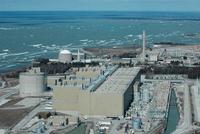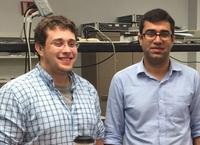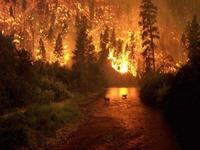-
Debate over Ontario, Canada underground nuclear waste facility intensifies

Ontario Power Generation’s (OPG) proposal to construct an underground nuclear waste disposal facility near the company’s Bruce Nuclear plantand on the edge of the Great Lakes is facing growing opposition from local municipalities and environmentalists. The facility would store low and intermediate nuclear waste from OPG’s Bruce, Pickering, and Darlington nuclear facilities. Environmentalists are concerned that a leak in the underground facility would be devastating for communities which depend on water from the Great Lakes.
-
-
Dynamic atolls give hope that Pacific Islands can defy sea rise
It is widely predicted that low-lying coral reef islands will drown as a result of sea-level rise, leaving their populations as environmental refugees. New evidence, however, now suggests that these small islands will be more resilient to sea-level rise than we thought. The new findings suggest that, rather than being passive lumps of rock that will be swamped by rising seas and eroded by storms, the islands are dynamic structures that can move and even grow in response to changing seas. Although the islands may survive into the future, the changes could still affect issues like fresh water and agriculture, potentially making life on these islands much more difficult than it is today.
-
-
“Dressed” laser aims at clouds to induce rain, lightning

The adage “Everyone complains about the weather but nobody does anything about it,” may one day be obsolete if researchers further develop a new technique to aim a high-energy laser beam into clouds to make it rain or trigger lightning. The researchers work on surround the beam with a second beam to act as an energy reservoir, sustaining the central beam to greater distances than previously possible. The secondary “dress” beam refuels and helps prevent the dissipation of the high-intensity primary beam. Gaining control over the length of a filament would allow the creation of the conditions needed for a rainstorm from afar. People could thus artificially control the rain and lightning over a large expanse.
-
-
More, bigger wildfires burning western U.S.

Wildfires across the western United States have been getting bigger and more frequent over the last thirty years — a trend that could continue as climate change causes temperatures to rise and drought to become more severe in the coming decades, according to new research.
-
-
Floating nuclear plants could ride out tsunamis
When an earthquake and tsunami struck the Fukushima Daiichi nuclear plant complex in 2011, neither the quake nor the inundation caused the ensuing contamination. Rather, it was the aftereffects — specifically, the lack of cooling for the reactor cores, due to a shutdown of all power at the station — that caused most of the harm. A new design for nuclear plants built on floating platforms, modeled after those used for offshore oil drilling, could help avoid such consequences in the future. Such floating plants would be designed to be automatically cooled by the surrounding seawater in a worst-case scenario, which would indefinitely prevent any melting of fuel rods, or escape of radioactive material.
-
-
A few “problem” shale gas wells source of greenhouse gas

High levels of the greenhouse gas methane were found above shale gas wells at a production point not thought to be an important emissions source, according to a new study. The findings could have implications for the evaluation of the environmental impacts from natural gas production. The study, which is one of only a few to use a so-called “top down” approach that measures methane gas levels in the air above wells, identified seven individual well pads with high emission levels and established their stage in the shale-gas development process.
-
-
U.S.-Mexico border security barriers affect movement of animals
Security barriers in national parks on the U.S.-Mexican border which aim to deter illegal migrants are affecting the movements of some native animal species while not necessarily restricting the movement of humans, according to new research.
-
-
Conventional theories about Titanic disaster are flawed
Previously it had been suggested that the seas which sank the famous cruise ship — which set off on its maiden voyage 102 years last week (Thursday 10 April 2014) — had an exceptional number of icebergs caused by lunar or solar effects. A new study finds, however, that the Titanic not unlucky for sailing in a year with an unusually high number of icebergs. In fact, the risk of icebergs higher now than it was in 1912.
-
-
Bangladesh tops list of countries at risk from sea level rise
Scientists say that see levels may rise by up to the feet by 2100.The implications of this would have drastic consequences for nearly all coastal nations, but the consensus is that Bangladesh will be the hardest hit by the change. Leading Bangladeshis say that since Bangladesh produces less than 0.3 percent of the emissions driving climate change, it would unjust for Bangladesh to rely on its own meager resources to solve this problem. One solution they offer: fifty million Bangladeshis (out of a population of 163 million) should be allowed to move to and resettle in the countries which produce the bulk of greenhouse gasses.
-
-
More stringent climate policies mean hard choices for coal plant operators
Limiting climate change to 2°C means shutting down coal power plants — an unpopular proposition for coal power companies. A new study shows, however, that delaying climate policies could prove even worse for power plant owners. The reason: new power plants being built now, especially in China and India, are built to run for 30-50 years, paying off only after years of operation. Stringent climate policies, however, could make the cost of emission so high that coal power generation is no longer competitive, leaving new power plants sitting idle and their owners and investors with huge losses — a problem known as stranded capacity.
-
-
Lead ammunition should be replaced by steel in shooting sports: experts
Researchers say that Olympic athletes specializing in shooting use one thousand cartridges per week and scatter some 1.3 tons of lead yearly, with harmful effects for surrounding animals and agricultural land. The researchers urge the International Olympic Committee and other sports organizations to replace lead ammunition with steel, which is non-toxic and contains similar technical characteristics.
-
-
U.S. corporations aware of current, future water risks
A new survey shows that nearly 60 percent of responding companies — the majority Fortune 500 and publically traded, representing virtually every industry sector — indicated that water is poised negatively to affect business growth and profitability within five years, while more than 80 percent said it will affect their decision on where to locate facilities. This is a stark increase from only five years ago, when water issues affected business growth and profitability for less than 20 percent of responding companies.
-
-
Using more wood for construction will reduce reliance on fossil fuels
A new study has found that using more wood and less steel and concrete in building and bridge construction would substantially reduce global carbon dioxide emissions and fossil fuel consumption. Despite an established forest conservation theory holding that tree harvesting should be strictly minimized to prevent the loss of biodiversity and to maintain carbon storage capacity, the study shows that sustainable management of wood resources can achieve both goals while also reducing fossil fuel burning.
-
-
Global insured losses from catastrophes were $45 billion in 2013
Total economic losses from natural catastrophes and man-made disasters were $140 billion in 2013. Global insured losses were around $45 billion in 2013, with large contributions from flooding and hail events. The economic losses of $140 billion were down from $196 billion in 2012, and below the 10-year average of $190 billion. Around 26,000 lives were lost in natural catastrophes and man-made disasters in 2013.
-
-
Southeast England residents most at risk of rising deaths from climate change
Warmer summers brought on by climate change will cause more deaths in London and southeast England than the rest of the country, scientists predict. Researchers looked at temperature records and mortality figures for 2001 to 2010 to find out which districts in England and Wales experience the biggest effects from warm temperatures. In the most vulnerable districts, in London and the southeast, the odds of dying from cardiovascular or respiratory causes increased by over 10 percent for every 1C rise in temperature.
-
More headlines
The long view
How Climate Change Will Affect Conflict and U.S. Military Operations
“People talk about climate change as a threat multiplier,” said Karen Sudkamp, an associate director of the Infrastructure, Immigration, and Security Operations Program within the RAND Homeland Security Research Division. “But at what point do we need to start talking about the threat multiplier actually becoming a significant threat all its own?”
